[English] 日本語
 Yorodumi
Yorodumi- PDB-3hkj: Crystal structure of human thrombin mutant W215A/E217A in complex... -
+ Open data
Open data
- Basic information
Basic information
| Entry | Database: PDB / ID: 3hkj | ||||||
|---|---|---|---|---|---|---|---|
| Title | Crystal structure of human thrombin mutant W215A/E217A in complex with the extracellular fragment of human PAR1 | ||||||
 Components Components |
| ||||||
 Keywords Keywords | HYDROLASE / Serine protease / Acute phase / Blood coagulation / Cleavage on pair of basic residues / Disease mutation / Disulfide bond / Gamma-carboxyglutamic acid / Glycoprotein / Kringle / Protease / Secreted / Zymogen / Cell membrane / G-protein coupled receptor / Membrane / Phosphoprotein / Receptor / Transducer / Transmembrane | ||||||
| Function / homology |  Function and homology information Function and homology informationnegative regulation of renin secretion into blood stream / dendritic cell homeostasis / trans-synaptic signaling by endocannabinoid, modulating synaptic transmission / platelet dense tubular network / establishment of synaptic specificity at neuromuscular junction / thrombin-activated receptor activity / regulation of interleukin-1 beta production / platelet dense granule organization / connective tissue replacement involved in inflammatory response wound healing / cell-cell junction maintenance ...negative regulation of renin secretion into blood stream / dendritic cell homeostasis / trans-synaptic signaling by endocannabinoid, modulating synaptic transmission / platelet dense tubular network / establishment of synaptic specificity at neuromuscular junction / thrombin-activated receptor activity / regulation of interleukin-1 beta production / platelet dense granule organization / connective tissue replacement involved in inflammatory response wound healing / cell-cell junction maintenance / positive regulation of smooth muscle contraction / positive regulation of calcium ion transport / cytolysis by host of symbiont cells / thrombospondin receptor activity / negative regulation of glomerular filtration / Defective factor XII causes hereditary angioedema / thrombin / thrombin-activated receptor signaling pathway / negative regulation of astrocyte differentiation / regulation of blood coagulation / positive regulation of phospholipase C-activating G protein-coupled receptor signaling pathway / neutrophil-mediated killing of gram-negative bacterium / Defective F8 cleavage by thrombin / positive regulation of vasoconstriction / positive regulation of Rho protein signal transduction / Platelet Aggregation (Plug Formation) / ligand-gated ion channel signaling pathway / positive regulation of collagen biosynthetic process / negative regulation of platelet activation / negative regulation of blood coagulation / positive regulation of blood coagulation / negative regulation of fibrinolysis / anatomical structure morphogenesis / G-protein alpha-subunit binding / Transport of gamma-carboxylated protein precursors from the endoplasmic reticulum to the Golgi apparatus / regulation of cytosolic calcium ion concentration / Gamma-carboxylation of protein precursors / Common Pathway of Fibrin Clot Formation / Removal of aminoterminal propeptides from gamma-carboxylated proteins / fibrinolysis / Intrinsic Pathway of Fibrin Clot Formation / negative regulation of proteolysis / release of sequestered calcium ion into cytosol / negative regulation of cytokine production involved in inflammatory response / homeostasis of number of cells within a tissue / Peptide ligand-binding receptors / Regulation of Complement cascade / positive regulation of release of sequestered calcium ion into cytosol / acute-phase response / Cell surface interactions at the vascular wall / positive regulation of interleukin-8 production / positive regulation of receptor signaling pathway via JAK-STAT / growth factor activity / neuromuscular junction / lipopolysaccharide binding / G protein-coupled receptor activity / positive regulation of insulin secretion / regulation of synaptic plasticity / caveola / platelet activation / positive regulation of interleukin-6 production / response to wounding / positive regulation of protein localization to nucleus / Golgi lumen / Regulation of Insulin-like Growth Factor (IGF) transport and uptake by Insulin-like Growth Factor Binding Proteins (IGFBPs) / positive regulation of reactive oxygen species metabolic process / blood coagulation / antimicrobial humoral immune response mediated by antimicrobial peptide / late endosome / G-protein beta-subunit binding / regulation of cell shape / heparin binding / : / Thrombin signalling through proteinase activated receptors (PARs) / positive regulation of cytosolic calcium ion concentration / positive regulation of cell growth / response to lipopolysaccharide / blood microparticle / phospholipase C-activating G protein-coupled receptor signaling pathway / G alpha (q) signalling events / negative regulation of neuron apoptotic process / postsynaptic membrane / early endosome / cell surface receptor signaling pathway / positive regulation of ERK1 and ERK2 cascade / positive regulation of canonical NF-kappaB signal transduction / positive regulation of phosphatidylinositol 3-kinase/protein kinase B signal transduction / positive regulation of MAPK cascade / positive regulation of cell migration / positive regulation of apoptotic process / G protein-coupled receptor signaling pathway / receptor ligand activity / endoplasmic reticulum lumen / inflammatory response / signaling receptor binding / negative regulation of cell population proliferation / serine-type endopeptidase activity / positive regulation of cell population proliferation / calcium ion binding / positive regulation of DNA-templated transcription Similarity search - Function | ||||||
| Biological species |  Homo sapiens (human) Homo sapiens (human) | ||||||
| Method |  X-RAY DIFFRACTION / X-RAY DIFFRACTION /  SYNCHROTRON / SYNCHROTRON /  MOLECULAR REPLACEMENT / Resolution: 2.6 Å MOLECULAR REPLACEMENT / Resolution: 2.6 Å | ||||||
 Authors Authors | Gandhi, P.S. / Page, M.J. / Chen, Z. / Bush-Pelc, L. / Di Cera, E. | ||||||
 Citation Citation |  Journal: J.Biol.Chem. / Year: 2009 Journal: J.Biol.Chem. / Year: 2009Title: Mechanism of the Anticoagulant Activity of Thrombin Mutant W215A/E217A. Authors: Gandhi, P.S. / Page, M.J. / Chen, Z. / Bush-Pelc, L. / Di Cera, E. #1:  Journal: J.Biol.Chem. / Year: 2004 Journal: J.Biol.Chem. / Year: 2004Title: The anticoagulant thrombin mutant W215A/E217A has a collapsed primary specificity pocket. Authors: Pineda, A.O. / Chen, Z.W. / Caccia, S. / Cantwell, A.M. / Savvides, S.N. / Waksman, G. / Mathews, F.S. / Di Cera, E. | ||||||
| History |
|
- Structure visualization
Structure visualization
| Structure viewer | Molecule:  Molmil Molmil Jmol/JSmol Jmol/JSmol |
|---|
- Downloads & links
Downloads & links
- Download
Download
| PDBx/mmCIF format |  3hkj.cif.gz 3hkj.cif.gz | 132.7 KB | Display |  PDBx/mmCIF format PDBx/mmCIF format |
|---|---|---|---|---|
| PDB format |  pdb3hkj.ent.gz pdb3hkj.ent.gz | 103.1 KB | Display |  PDB format PDB format |
| PDBx/mmJSON format |  3hkj.json.gz 3hkj.json.gz | Tree view |  PDBx/mmJSON format PDBx/mmJSON format | |
| Others |  Other downloads Other downloads |
-Validation report
| Arichive directory |  https://data.pdbj.org/pub/pdb/validation_reports/hk/3hkj https://data.pdbj.org/pub/pdb/validation_reports/hk/3hkj ftp://data.pdbj.org/pub/pdb/validation_reports/hk/3hkj ftp://data.pdbj.org/pub/pdb/validation_reports/hk/3hkj | HTTPS FTP |
|---|
-Related structure data
| Related structure data |  3hk3C  3hk6C 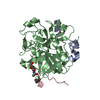 3hkiC 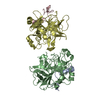 1tq0S S: Starting model for refinement C: citing same article ( |
|---|---|
| Similar structure data |
- Links
Links
- Assembly
Assembly
| Deposited unit | 
| ||||||||
|---|---|---|---|---|---|---|---|---|---|
| 1 | 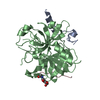
| ||||||||
| 2 | 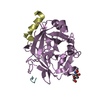
| ||||||||
| Unit cell |
| ||||||||
| Details | THE BIOLOGICAL ASSEMBLY CONSISTS OF A, B AND C CHAINS. |
- Components
Components
| #1: Protein/peptide | Mass: 3647.075 Da / Num. of mol.: 2 / Fragment: Light chain: UNP residues 333-363 Source method: isolated from a genetically manipulated source Source: (gene. exp.)  Homo sapiens (human) / Gene: F2 / Cell (production host): BHK cells / Organ (production host): baby hamster kidney / Production host: Homo sapiens (human) / Gene: F2 / Cell (production host): BHK cells / Organ (production host): baby hamster kidney / Production host:  #2: Protein | Mass: 29607.055 Da / Num. of mol.: 2 / Fragment: Heavy chain: UNP residues 364-622 / Mutation: W215A, E217A Source method: isolated from a genetically manipulated source Source: (gene. exp.)  Homo sapiens (human) / Gene: F2 / Cell (production host): BHK cells / Organ (production host): baby hamster kidney / Production host: Homo sapiens (human) / Gene: F2 / Cell (production host): BHK cells / Organ (production host): baby hamster kidney / Production host:  #3: Protein/peptide | Mass: 2673.862 Da / Num. of mol.: 2 / Fragment: Extracellular fragment: UNP residues 42-62 Source method: isolated from a genetically manipulated source Source: (gene. exp.)  Homo sapiens (human) / Gene: F2R, CF2R, PAR1, TR / Cell (production host): BHK cells / Organ (production host): baby hamster kidney / Production host: Homo sapiens (human) / Gene: F2R, CF2R, PAR1, TR / Cell (production host): BHK cells / Organ (production host): baby hamster kidney / Production host:  #4: Sugar | #5: Water | ChemComp-HOH / | Has protein modification | Y | |
|---|
-Experimental details
-Experiment
| Experiment | Method:  X-RAY DIFFRACTION / Number of used crystals: 1 X-RAY DIFFRACTION / Number of used crystals: 1 |
|---|
- Sample preparation
Sample preparation
| Crystal | Density Matthews: 2.85 Å3/Da / Density % sol: 56.92 % |
|---|---|
| Crystal grow | Temperature: 295 K / Method: vapor diffusion, hanging drop / pH: 7.5 Details: 100mM HEPES pH 7.5, 20% PEG 10000, VAPOR DIFFUSION, HANGING DROP, temperature 295K |
-Data collection
| Diffraction | Mean temperature: 100 K |
|---|---|
| Diffraction source | Source:  SYNCHROTRON / Site: SYNCHROTRON / Site:  APS APS  / Beamline: 14-BM-C / Wavelength: 0.9 Å / Beamline: 14-BM-C / Wavelength: 0.9 Å |
| Detector | Type: ADSC QUANTUM 315 / Detector: CCD / Date: Oct 27, 2008 |
| Radiation | Monochromator: Bent Ge(111) / Protocol: SINGLE WAVELENGTH / Monochromatic (M) / Laue (L): M / Scattering type: x-ray |
| Radiation wavelength | Wavelength: 0.9 Å / Relative weight: 1 |
| Reflection | Resolution: 2.6→40 Å / Num. all: 24771 / Num. obs: 22864 / % possible obs: 93.4 % / Observed criterion σ(I): -3 / Redundancy: 3 % / Biso Wilson estimate: 31.7 Å2 / Rmerge(I) obs: 0.052 / Net I/σ(I): 18.5 |
| Reflection shell | Resolution: 2.6→2.69 Å / Redundancy: 2.6 % / Rmerge(I) obs: 0.199 / Mean I/σ(I) obs: 4.2 / Num. unique all: 1956 / % possible all: 79.3 |
- Processing
Processing
| Software |
| ||||||||||||||||||||
|---|---|---|---|---|---|---|---|---|---|---|---|---|---|---|---|---|---|---|---|---|---|
| Refinement | Method to determine structure:  MOLECULAR REPLACEMENT MOLECULAR REPLACEMENTStarting model: PDB entry 1TQ0 Resolution: 2.6→37.17 Å / Rfactor Rfree error: 0.007 / Data cutoff high absF: 127702.59 / Data cutoff low absF: 0 / Isotropic thermal model: RESTRAINED / Cross valid method: THROUGHOUT / σ(F): 0 / σ(I): 0 / Stereochemistry target values: Engh & Huber
| ||||||||||||||||||||
| Displacement parameters | Biso mean: 40.8 Å2 | ||||||||||||||||||||
| Refine analyze |
| ||||||||||||||||||||
| Refinement step | Cycle: LAST / Resolution: 2.6→37.17 Å
| ||||||||||||||||||||
| Refine LS restraints |
| ||||||||||||||||||||
| LS refinement shell | Resolution: 2.6→2.76 Å / Rfactor Rfree error: 0.026 / Total num. of bins used: 6
|
 Movie
Movie Controller
Controller


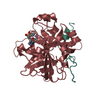
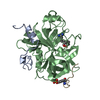

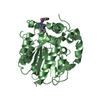
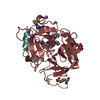
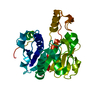




 PDBj
PDBj


















